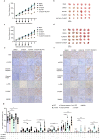Non-small cell lung cancers (NSCLCs) oncolysis using coxsackievirus B5 and synergistic DNA-damage response inhibitors
- PMID: 37743418
- PMCID: PMC10518312
- DOI: 10.1038/s41392-023-01603-4
Non-small cell lung cancers (NSCLCs) oncolysis using coxsackievirus B5 and synergistic DNA-damage response inhibitors
Abstract
With the continuous in-depth study of the interaction mechanism between viruses and hosts, the virus has become a promising tool in cancer treatment. In fact, many oncolytic viruses with selectivity and effectiveness have been used in cancer therapy. Human enterovirus is one of the most convenient sources to generate oncolytic viruses, however, the high seroprevalence of some enteroviruses limits its application which urges to exploit more oncolytic enteroviruses. In this study, coxsackievirus B5/Faulkner (CV-B5/F) was screened for its potential oncolytic effect against non-small cell lung cancers (NSCLCs) through inducing apoptosis and autophagy. For refractory NSCLCs, DNA-dependent protein kinase (DNA-PK) or ataxia telangiectasia mutated protein (ATM) inhibitors can synergize with CV-B5/F to promote refractory cell death. Here, we showed that viral infection triggered endoplasmic reticulum (ER) stress-related pro-apoptosis and autophagy signals, whereas repair for double-stranded DNA breaks (DSBs) contributed to cell survival which can be antagonized by inhibitor-induced cell death, manifesting exacerbated DSBs, apoptosis, and autophagy. Mechanistically, PERK pathway was activated by the combination of CV-B5/F and inhibitor, and the irreversible ER stress-induced exacerbated cell death. Furthermore, the degradation of activated STING by ERphagy promoted viral replication. Meanwhile, no treatment-related deaths due to CV-B5/F and/or inhibitors occurred. Conclusively, our study identifies an oncolytic CV-B5/F and the synergistic effects of inhibitors of DNA-PK or ATM, which is a potential therapy for NSCLCs.
© 2023. West China Hospital, Sichuan University.
Conflict of interest statement
The authors declare no competing interests.
Figures







Similar articles
-
Synergistic anti-tumor efficacy of oncolytic influenza viruses and B7-H3 immune- checkpoint inhibitors against IC-resistant lung cancers.Oncoimmunology. 2021 Feb 17;10(1):1885778. doi: 10.1080/2162402X.2021.1885778. Oncoimmunology. 2021. PMID: 33643696 Free PMC article.
-
Enhanced therapeutic efficacy of oncolytic herpes vector G207 against human non-small cell lung cancer--expression of an RNA-binding protein, Musashi1, as a marker for the tailored gene therapy.J Gene Med. 2006 Nov;8(11):1329-40. doi: 10.1002/jgm.965. J Gene Med. 2006. PMID: 16955534
-
[Synergistic Effect of NF-κB Signaling Pathway Inhibitor and Oncolytic Measles Virus Vaccine Strain against Lung Cancer and Underlying Mechanisms].Zhongguo Fei Ai Za Zhi. 2021 Apr 20;24(4):245-253. doi: 10.3779/j.issn.1009-3419.2021.102.14. Epub 2021 Mar 29. Zhongguo Fei Ai Za Zhi. 2021. PMID: 33775041 Free PMC article. Chinese.
-
[Oncolytic enteroviruses].Mol Biol (Mosk). 2012 Sep-Oct;46(5):712-25. Mol Biol (Mosk). 2012. PMID: 23156670 Review. Russian.
-
Immunotherapy for thoracic oncology gone viral.Immunotherapy. 2018 Apr;10(5):383-390. doi: 10.2217/imt-2017-0148. Immunotherapy. 2018. PMID: 29473469 Review.
Cited by
-
Oncolytic virotherapy against lung cancer: key receptors and signaling pathways of viral entry.Front Immunol. 2024 Oct 4;15:1473288. doi: 10.3389/fimmu.2024.1473288. eCollection 2024. Front Immunol. 2024. PMID: 39430750 Free PMC article. Review.
-
For better or worse: crosstalk of parvovirus and host DNA damage response.Front Immunol. 2024 Feb 23;15:1324531. doi: 10.3389/fimmu.2024.1324531. eCollection 2024. Front Immunol. 2024. PMID: 38464523 Free PMC article. Review.
-
Combination therapy with oncolytic viruses for lung cancer treatment.Front Oncol. 2025 Apr 3;15:1524079. doi: 10.3389/fonc.2025.1524079. eCollection 2025. Front Oncol. 2025. PMID: 40248194 Free PMC article. Review.
-
Combination strategies of gut microbiota in cancer therapy through metabolic reprogramming and immune remodeling.Cell Commun Signal. 2025 Jun 5;23(1):270. doi: 10.1186/s12964-025-02275-z. Cell Commun Signal. 2025. PMID: 40474258 Free PMC article. Review.
-
Smart delivery vehicles for cancer: categories, unique roles and therapeutic strategies.Nanoscale Adv. 2024 Jun 20;6(17):4275-4308. doi: 10.1039/d4na00285g. eCollection 2024 Aug 20. Nanoscale Adv. 2024. PMID: 39170969 Free PMC article. Review.
References
Publication types
MeSH terms
Substances
LinkOut - more resources
Full Text Sources
Medical
Research Materials
Miscellaneous

